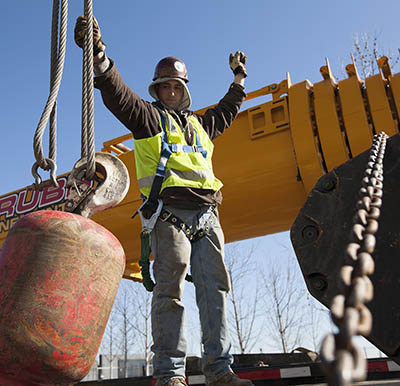 December 2020—The federal Occupational Safety and Health Administration (OSHA) has specific—but different—qualification requirements for signalpersons and riggers. In both cases people often wonder whether “certification” equals “qualification,” and, if not, what the difference is. The main difference is the level of testing required. Qualification is done by the employer and may or may not involve formal testing; it is at the discretion of the employer’s qualified evaluator. Certification requires third-party testing to provide a consistent and accurate means to determine a person’s technical knowledge and hands-on skills related to the task.
December 2020—The federal Occupational Safety and Health Administration (OSHA) has specific—but different—qualification requirements for signalpersons and riggers. In both cases people often wonder whether “certification” equals “qualification,” and, if not, what the difference is. The main difference is the level of testing required. Qualification is done by the employer and may or may not involve formal testing; it is at the discretion of the employer’s qualified evaluator. Certification requires third-party testing to provide a consistent and accurate means to determine a person’s technical knowledge and hands-on skills related to the task.
What does OSHA require?
Specifically, OSHA CFR 1926.1428(c) requires that signalpersons know and understand basic hand signals; be competent in the application of the type of signals used (e.g., hand, radio); have a basic understanding of the crane’s operation and limitations; and understand when it is appropriate to use hand, radio, or special signals. Most importantly, they must demonstrate qualification through an oral or written exam and a thorough practical exam, either by an accredited third-party qualified evaluator, such as the National Commission for the Certification of Crane Operators (NCCCO), or the employer’s qualified evaluator. Fortunately, all of these are features of NCCCO’s Signalperson certification, so in this case CCO-certified Signalpersons are by definition qualified.
The requirements for Riggers are less concrete. In some circumstances, OSHA requires employers to always use qualified riggers. These include any hoisting activities relating to the assembly and disassembly of the rig. Qualified riggers must also be used whenever there will be other workers inside the fall zone (the area directly under a load or the expanded area a load could fall into). Qualified riggers must also be used whenever workers will be guiding a load, hooking and unhooking a load, or connecting a load to a structure while it is still attached to the rig.
According to OSHA, it is the responsibility of the employer to determine whether a person is qualified to be a rigger. Having a degree, certificate, or professional accreditation as a rigger is one way to qualify as a rigger. Formal qualification or certification in rigging is not required, as long as the employer can show the rigger has knowledge, experience, and training in rigging and can demonstrate the ability to solve rigging problems. Employers are not required to have riggers independently tested or assessed, but CCO certification can certainly assist in documenting that an individual is a qualified rigger.
Why certify rather than just qualify?
The process to qualify signalpersons and/or riggers can be done with less preparation than is required for certification. However, because there is no or minimal training required, the qualification process does not provide the means to fully evaluate whether a signalperson and/or rigger truly has the technical knowledge and hands-on skills to competently and safely perform crane signaling or rigging duties.
To pass signalperson and/or rigger certification exams and earn certification, comprehensive training is generally required to gain adequate technical knowledge and hands-on skills. Certification courses generally last from a few days to a few weeks and cover areas such as slings, knots, signaling, load control, and safety issues. As a result, signalpersons and/or riggers who have achieved certification—because of the training and testing processes—will have the ability to perform their jobs tasks more safely and effectively.
How are signalpersons and/or riggers usually prepared for the certification exams?
A quality training program will provide a good combination of technical knowledge and hands-on examples to show application of the principles and techniques taught. Most quality training provides ample opportunity for hands-on instruction using pre-made scenarios that require the candidates to apply the technical knowledge they learned in the classroom. During training the hands-on scenarios should be assessed, and proper feedback given to the candidates to ensure complete understanding of the concepts and techniques learned. The training usually includes a pre-certification written exam so the candidate and the trainer can assess comprehension. In this way, the training is more than just “teaching to the test.”
Is it important to maintain signalperson and/or rigger certification(s)?
All accredited certification programs have a periodic recertification requirement to maintain the credential. Crane technology is ever-changing. Types of rigging and associated rigging techniques can change due to new technologies and materials. Recertification ensures that the certificant has stayed current with the latest technologies, standards, and regulations. And the recertification requirement motivates certificants to stay sharp, improve their skills, and not get complacent.
After all, any credential that is worth having is worth keeping!
This article is adapted from a presentation made by Ray Feidt, Corporate Inspection/Training Manager, Stephenson Equipment, Inc., at the 5th Annual Industry Forum on Personnel Qualifications presented by the NCCCO Foundation in October. For further details of the Forum and access to the live presentation go to ncccofoundation.org.